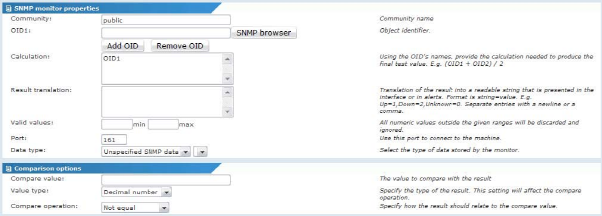SNMP
Monitor description
The SNMP monitor is a dynamic tool for querying multiple object identifiers (OID) from an remote SNMP agent and perform calculations on the returned values.
- System type: All
- Category: SNMP

SNMP monitor property page
Monitor specific properties
The monitor features a dynamic number of OID fields that are added and removed with the buttons below the field. The SNMP browser button next to the OID field can be used to select object identifiers from the remote SNMP agent.
- Community - SNMP community to use. Defaults to
public. - Calculation - A calculation using the values queried from the object identifiers. The example in the image above calculates the network utilization from an interface.
- Result translation - Translates the result into a readable string. This option is only available when the value type in the comparison is set to
string. See below for example. - Min/Max valid value - Enables the monitor to filter out all values below and above the given threshold.
- Port number - Port to use. Defaults to
161. - Data type - The unit of data sampled by the test. This makes it possible to group data from this type of monitor with other monitors such as
CPU utilizationin reports. - Compare value - Value to compare with the resulting value from the calculation.
- Value type - Type of value that is compared with the retrieved value.
- Operation - Operation to use when comparing.
Result translation
The result translation feature can be used to translate a non-descriptive OID value into a readable string. This feature is only available if the comparison value type is set to string. The OID value retrieved can still be a numeric value, but is treated as a string.
Example 1
Unknown(1), Alarm(2), Failed(3), Ok(4)
Example 2
Unknown=1,Alarm=2,Failed=3,OK=4
The values 1, 2, 3 and 4 are translated to Unknown, Alarm, Failed and OK. Both examples above are valid notations.
The final translated string is the string used in the comparison operation.
Topic 8883: Send Feedback. Download a PDF of this online book from the first topic in the table of contents. Print this topic.